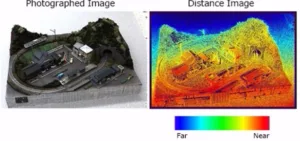At the 22nd Symposium on Sensing via Image Information held this past June, Toshiba announced developments related to a new method for creating 3D images. The technique simultaneously acquires a color image and a depth map from just one image that is captured by a single lens camera. The technique is reported as able to measure distance to a high degree of precision through the use of a simple device added to the lens and image processing.
A recent article on the technology starts by presenting a review of the advantages and disadvantages of the more significant current distance measuring technologies. These were summarized as follows.
- Stereo cameras can be used to detect distance through the use of triangulation. To achieve a high degree of measurement accuracy, it is necessary that the distance between the two camera lenses be no less than about 30 cm. As a consequence, it is difficult to produce a miniaturized device.
- In “Structure from Motion” technology, distance is determined from multiple images taken from multiple viewpoints that, in turn, are obtained by moving the camera around the object. Using this technique, it is difficult to accurately measure the distance of a moving object.
- An infrared based approach consists of illuminating the scene with an infrared pattern and then determining distances from shifts in the pattern. It is found that, with this technique, it is difficult to accurately measure distances to objects located further than about 10 m from the detector.
- Ultrasonic distance sensors use ultrasonic sound to illuminate the scene. Distances are determined from differences in the reception times of the reflected waves. Measuring objects at distances greater than 10 m is difficult.
- In the millimeter wave radar approach, the scene is illuminated with millimeter micro waves. Distances are determined from the differences in reception times of the reflected waves. Millimeter wave radar devices are both difficult to miniaturize and expensive.
- LiDAR (Light Detection and Ranging). In this approach, a light beam is used to illuminate the scene. Distances are determined from differences in the reception times of the reflected waves. LiDAR devices are both difficult to miniaturize and expensive.
The authors conclude that it is difficult for all of the conventional approaches to achieve a high degree of distance measuring accuracy in a compact, low cost package. The technique developed by Toshiba was chosen to address these issues and is described as follows.
“By attaching a proprietary color aperture filter consisting of blue and yellow filters to the lens aperture, a combination of blur and color shift occurs, and this combination depends on the distance to the object. Distance to the object is detected for each pixel through image analysis from the blur and color deviation obtained within a single photographic image. Deterioration in the quality of the captured image is also suppressed, because this color filter allows transmission of green light, which has a higher contribution ratio to overall image brightness.”
Toshiba conducted distance measurement tests utilizing their new technique and did so using a commercially available camera. The company reported that the distance accuracy obtained using the new technique was comparable to that obtainable by a stereo camera that has lenses 35 cm apart. The researchers, therefore, conclude that it is possible to construct an inexpensive image sensor using the new method.
Looking forward, the company has stated that their objective is to miniaturize the camera and speed up image processing. Toshiba’s stated goal is to achieve early design wins for the new technology. – Arthur Berman

